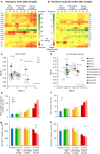High intensity perturbations induce an abrupt shift in soil microbial state
- PMID: 37814127
- PMCID: PMC10690886
- DOI: 10.1038/s41396-023-01512-y
High intensity perturbations induce an abrupt shift in soil microbial state
Abstract
Soil microbial communities play a pivotal role in regulating ecosystem functioning. But they are increasingly being shaped by human-induced environmental change, including intense "pulse" perturbations, such as droughts, which are predicted to increase in frequency and intensity with climate change. While it is known that soil microbial communities are sensitive to such perturbations and that effects can be long-lasting, it remains untested whether there is a threshold in the intensity and frequency of perturbations that can trigger abrupt and persistent transitions in the taxonomic and functional characteristics of soil microbial communities. Here we demonstrate experimentally that intense pulses of drought equivalent to a 30-year drought event (<15% WHC) induce a major shift in the soil microbial community characterised by significantly altered bacterial and fungal community structures of reduced complexity and functionality. Moreover, the characteristics of this transformed microbial community persisted after returning soil to its previous moisture status. As a result, we found that drought had a strong legacy effect on bacterial community function, inducing an enhanced growth rate following subsequent drought. Abrupt transitions are widely documented in aquatic and terrestrial plant communities in response to human-induced perturbations. Our findings demonstrate that such transitions also occur in soil microbial communities in response to high intensity pulse perturbations, with potentially deleterious consequences for soil health.
© 2023. The Author(s).
Conflict of interest statement
The authors declare no competing interests.
Figures




References
-
- Yodzis P. The stability of real ecosystems. Nature. 1981;289:674–6. doi: 10.1038/289674a0. - DOI
-
- Naumann G, Alfieri L, Wyser K, Mentaschi L, Betts RA, Carrao H, et al. Global changes in drought conditions under different levels of warming. Geophys Res Lett. 2018;45:3285–96. doi: 10.1002/2017GL076521. - DOI
MeSH terms
Substances
Grants and funding
- BB/S010661/1/RCUK | Biotechnology and Biological Sciences Research Council (BBSRC)
- BB/I009000/2/RCUK | Biotechnology and Biological Sciences Research Council (BBSRC)
- KAW 2017.0171/Knut och Alice Wallenbergs Stiftelse (Knut and Alice Wallenberg Foundation)
- KAW 2022.01745/Knut och Alice Wallenbergs Stiftelse (Knut and Alice Wallenberg Foundation)
- 883621/EC | EU Framework Programme for Research and Innovation H2020 | H2020 Priority Excellent Science | H2020 European Research Council (H2020 Excellent Science - European Research Council)
LinkOut - more resources
Full Text Sources
Research Materials

